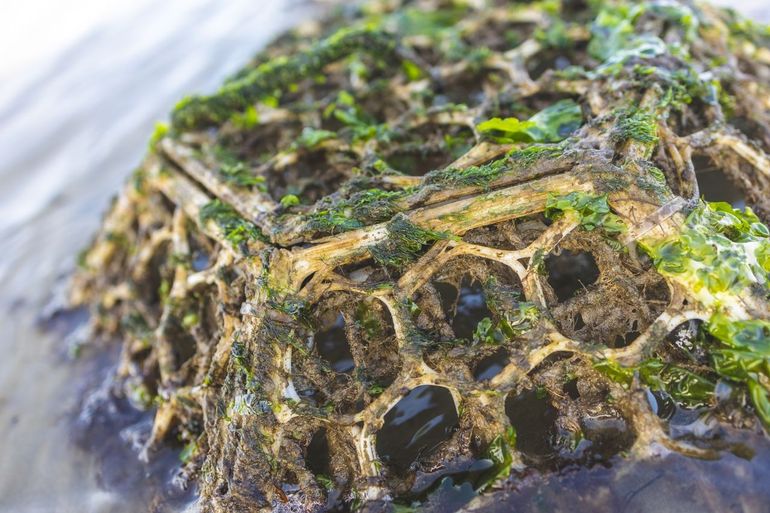Young mussels cling to 3D-printed, biodegradable reefs. This is evident from a test on the mudflats near Texel, an island in the Netherlands. Researchers hope that the reefs can help the growth of mussel banks, because these banks are important for biodiversity. The Dutch nature management organization wants to expand the mussel banks, but not all experts think this makes sense.
"We are actually imitating adult mussel beds," says researcher Tjisse van der Heide of the Netherlands Institute for Sea Research. "Existing mussel banks offer support and protection against predators such as shrimps, crabs and starfish. This means that young mussels survive more easily on such a bank than on a bare sandy bottom. Ultimately, the printed material must break down and a natural mussel bank remains."
Shellfish researcher Troost is critical of the artificial reefs. "Why do you tinker with non-natural materials in a nature reserve? There is enough hard surface to which mussels can attach. Moreover, the mussel population below the water surface maintains itself. There is a legal task to allow mussel beds to age, but not to create more mussel beds than there are now."
Last May, Van der Heide and his colleagues placed about thirty artificial reefs of about half a square meter on a tidal flat near Texel. The reefs are made of biopolymers; a type of biodegradable plastic. There are cavities in which young mussels can hide. The researchers used coconut rope in some of the reefs because its texture resembles the threads with which adult mussels hold each other.
In the laboratory in the coming months, the researchers will count how many mussels there are in the reefs and how heavy they are. "But we can also see with the naked eye that young mussels have succeeded in establishing themselves here," says Van der Heide. "So the principle works, both for reefs that are permanently under water and for reefs that dried up at low tide."
Kickstarters of biodiversity
A healthy and rich Wadden Sea consists of organic farmers. These are animal species that influence their own environment in such a way that they create ideal living conditions and provide habitat for many other species. “Biobuilders are kickstarters of biodiversity. In the Wadden Sea, reef-forming shellfish, especially mussels and oysters, are important biobuilders. For successful settlement on an empty tidal flat, these species often need a boost, because their larvae are prey for crabs or are washed away by the waves,” explains Ralph Temmink. Temmink is a marine ecologist at Utrecht University and one of the researchers of the Building with Biobuilders project.
Temporary 3D-printed artificial reef structures could make the difference between a barren sandbar and a reef by providing shelter from predators and waves for young mussel and oyster larvae. “In fact, the structures simulate a mature reef, which naturally provides protection and thus forms a foundation for the next generation. The artificial reefs must temporarily take over that role on the bare sand. When the mussels and oysters are large enough to form the reef themselves, the underlying structure breaks down completely. So in net terms, no 3D-printed material is left behind, but a natural reef is left behind,” says Temmink.
Van der Heide is investigating whether natural processes can be accelerated and, as a coastal ecologist, he also believes it is important to expand the mussel beds. "Those banks are indeed stable, but that is in the current situation. Without fishing, the surface area would almost certainly be larger and you want to move towards mussel banks as they can occur naturally in the Wadden Sea."Next year he will test 3D-printed reefs in the sea again. "We now see that the reefs with coconut rope and small cavities are the most attractive for the mussels. On this basis we can refine the design." Moreover, Van der Heide wants to apply the knowledge acquired worldwide for the restoration of endangered shovel reefs.

Hendrick Marvel
I wanted and fought very hard to win the lottery that didn't come to pass until I found out about Dr Ozigidon Lottery spell. Dr Ozigidon is the real deal. My name is Hendrick Marvel, I'm from Ohio United states. I just want everyone to know about Dr Ozigidon, he helped me win a lot of money sometimes ago in lottery, I have played a couple of times and I have never won , I contacted him after watching a video of how he cure a woman of a deadly sickness. I told him I want to win the lottery and become rich to clear the debt I owe. He said if you can pay for the spell before the next draw, then consider yourself a millionaire. I had to loan money from a colleague to get the spell done. He gave me some lucky winning numbers, and he also instructed me on how to go about it, i played and i won $33,750,000 THIRTY-THREE MILLION, SEVEN HUNDRED, FIFTY THOUSAND DOLLARS, I have never seen such money all my life, but with the help of Dr Ozigidon, now I have that much, if you ever need help in getting lottery winning numbers to enable you win much money to pay for anything you wish for in life., do not hesitate to contact Dr Ozigidon, he did the unthinkable for me. contact him via his Email: drozigidonhenz.spell.net@gmail.com Whats , App. him now +2349054750112
Posted on